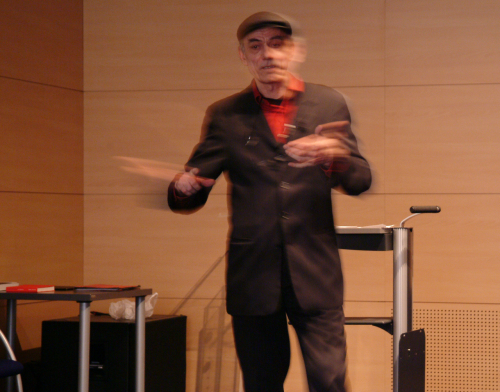This is the first time since the initial exhibitions of the Ludwig Museum in 1991 and the Museum of Contemporary Art in 1996 that the Museum’s own collection has been put in full focus: some three hundred of the five hundred items it holds will be on display on the three floors of the Museum. Forming the core of the collection are the seventy works which the Ludwigs donated to the museum in 1989, and the further ninety-five pieces they put on deposit two years later. By this act of immeasurable value and significance, they brought to the Hungarian public artistic achievements of the second half of the twentieth century which had hitherto only been seen in reproduction, filling a void that the absence of these points of reference had caused in the education of art history and fine arts.
The permanent exhibition arranged by Katalin Néray, which opened in 2005, has been left virtually unchanged on the 3rd floor, with some minor additions, offering an art-historical overview of international and Hungarian art trends from the 1960s to the 1990s. The imaginary line starts with two major Picasso paintings, whose qualities acquired special attention through the expressive painting of the 1980s. The Ludwigs, who started building what became Europe’s largest pop-art collection in the 1960s, brought to Budapest emblematic works by American and British artists (Warhol, Lichtenstein, Oldenburg etc.), and some outstanding pieces of photo-realism (Close, Morley). Juxtaposed with these are some important pieces of progressive Hungarian painting from the 1960s (Keserü, Bak, Nádler). One or two distinctive works also give a glimpse of European trends (Tinguely, Appel, Hantai). Art with social and political themes starts off with paintings by Vostell and Richter and continues with pre-transition Eastern European works (Gulyás, Pinczehelyi, Lejderman, Nazarenko etc.). Movements of the seventies and eighties – Conceptual Art, Fluxus, Performance and Body Art – are represented by purchases of recent years (Rainer, Beuys, Erdély, Lakner, Maurer, Hajas and others). Finally, the new painting of the 1980s is presented in works by A. R. Penck, Baselitz, Birkás, Fehér, Kelemen, Bak and others.
The works on the first floor complement and extend the compilation: more attention is paid to the international painting and sculpture from the sixties to the eighties and to the Hungarian and Central European art of the nineties, which has received new emphasis in the collection since the foundation of the Museum of Contemporary Art in 1996. That was when, through the cultural ministry’s support and purchasing schemes, several dozen works representative of the era came into the Museum’s possession. Their presentation here seeks for links between the works and explores the changes of attitude in painting and sculpture, and changes in art forms.
The second floor presents works of the younger generation of artists who started out in the nineties. These bear witness to an artistic paradigm change in the last decade, a period when new media, art forms and themes have come to the fore; particularly prominent have been the political and economic transition itself, and body and gender issues, not to mention the new media era which has begun in photography and painting. (On view through to 10 February 2008.)
One of the most important developments, the advance of video and video installations, will be presented after the rearrangement of the permanent exhibition in February, when a new selection of the Museum’s video collection will go on show under the title All that Cinema (on the first floor).
Related contents

VIVA FOTOFILM 23. February, 2008–25.
Lecture and screening series
Films are selected by Gusztáv Hámos, Katja Pratschke and Thomas Tode
“I can no longer think what I want. The moving pictures have taken the place of my thoughts.” (Georg Duhamel: Scènes de la vie future, Paris 1930, p. 52)